Most ants are foragers, which means they leave their nest to go out and find their food. They leave a trail of pheromones behind when a food source is located. This ensures that other ants can find their way to the food, collect it, and carry it back to their nest.
Ants eat almost everything. Like people, they are omnivores. That means that their diet consists of plants and animals, providing them with sources of both carbohydrates and protein. The most common foods for ants are plants, seeds, nectar, fruits, grains, other insects, and honeydew secretion, a sweet liquid secreted by aphids and some scale insects.
There are more than 10,000 different species of ants all over the world. While we can’t cover them all in this article, let’s look at some more well-known types of ants and what they like to eat.
How Do Ants Find and Eat Food?
There are several different specialist groups within ant society. The responsibility of locating and recognizing plentiful food sources nearby is delegated to worker ants.
The worker ant leaves a chemical trail for all the other ants to track as it returns to the nest. These pheromones are exclusive to that colony and aid in delineating its boundaries so that other colonies won’t trespass.
Ants can lift or hold food in place with the help of their powerful mandibles. Like every animal, they chew the food and combine it with saliva.
What Do Ants Drink?
Ants may obtain most of the moisture they require for proper hydration from the items they eat, but they nevertheless like the occasional sip of water or a sugary beverage.
Types of Food Ants Eat
Ants are typically drawn to insects and plant matter, especially sweet substances. They relish hunting out human food as well. But it seems like they’ll eat just about everything.
Sugar & Honeydew
Sugary meals are what most ants are drawn to. They are attracted to honey, sugar, syrup, and candy in their houses because of this.
Some ant species depend on aphids to sate their sweet taste outside, where sugar may be hard to come by. Some ants have evolved a symbiotic relationship with aphids. They gain access to the honeydew the aphids produce as an exchange for security from predators who may attack the aphids.
Proteins
Protein-rich foods are essential for ants to grow and develop appropriately. To guarantee that they have enough protein for the ant larvae to develop, ants frequently devour proteins like those found in foods like peanut butter, eggs, fats, and other insects.
Seeds & Grains
Some harvester ant species only consume the seeds and grains of nearby plant life as food. Because they are essential to the growth of regional plant life, these ants are frequently referred to as agricultural ants.
Fungus
Some leaf cutter ant species cultivate fungal patches to provide food for their larvae. These leafcutting species expose the pulp they create after chewing the leaves to mycelium growth, which encourages the growth of fungi. The fungus is extracted from the leaf pulp and fed to the larvae to help them grow into adults.
Termites & Other Insects
Some ant species engage in solitary insect hunting or band together to raid the nest or colony of a rival species. Termite colonies have been reported to be attacked by carpenter ants, who subsequently scavenge the termite eggs and larvae before taking control of the colony. Insects that are significantly larger than them will be hunted and dismembered by other ants acting in groups.
Different Types of Ants and Their Feeding Habits
What Do Carpenter Ants Eat?
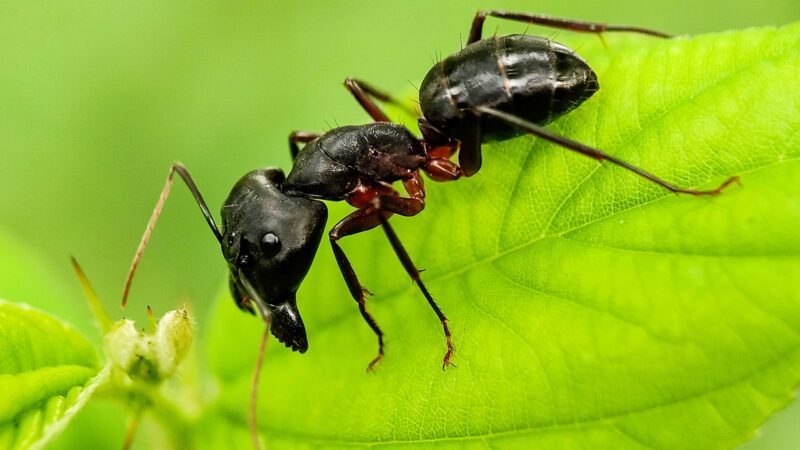
Carpenter ants are known for destroying wood in and around the home, causing structural problems. While this is true, it isn’t because they eat wood for food! They chew and burrow into the wood to make their nests. In their natural environment, carpenter ants eat things like other similar insects, including honeydew secretion.
If carpenter ants find their way into your home, they will feed on sweet things like jelly, honey, and sugar and eat your pet’s food.
What Do Fire Ants Eat?
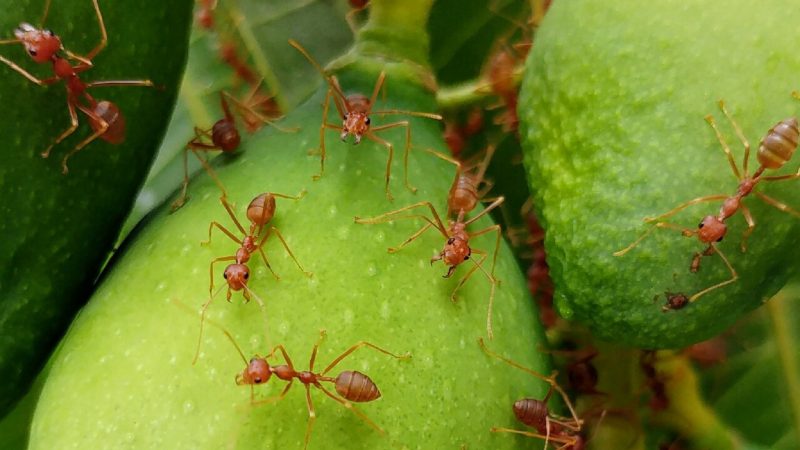
Fire ants are known for their nasty bite. They grip onto their prey (or unsuspecting picnicker) and inject venom with a stinger located between their jaws. They will eat worms, ticks, spiders, seeds, honeydew, other insects, and sweet foods.
What Do Red Ants Eat?
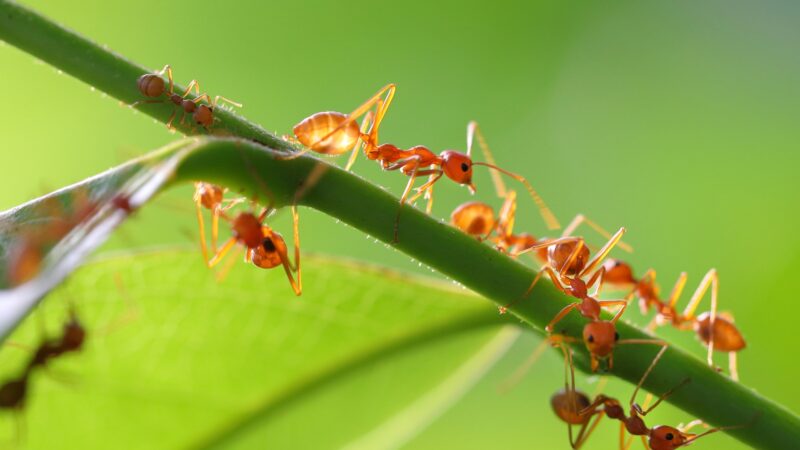
Red ants have a similar diet to fire ants, only they are more well-known for their venomous sting. Red ants have a stinger on the end of their abdomen, which they use to inject paralyzing venom into their prey. They consume the larvae and the dead animal’s flesh if they come across a dead animal infested with fly larvae (maggots).
This provides an additional protein source for the ants and ensures that more of the carcass will be left for them. Also, they eat “regular” ant food as well.
What Do Flying Ants Eat?
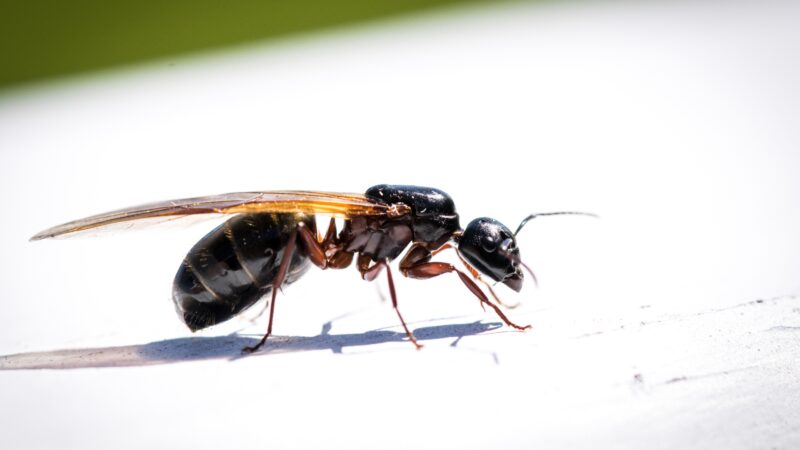
Although they can take flight, the flying ants’ diet doesn’t differ much from their ground-dwelling cousins. They consume both plant-based foods as well as animal proteins.
Important: If you’ve spotted flying ants in or around your home, take a second look. You may be dealing with termites, which look very similar! Watch for the following differences.
Termites:
- Four wings of equal size
- Straight bodies
- Straight antenna
Whereas flying ants:
- Front wings are longer than their back wings
- Bent antennae
- Defined abdomen
If you are unsure, contact a professional. A termite problem could cause severe structural damage to your home.
What Do Leafcutter Ants Eat?
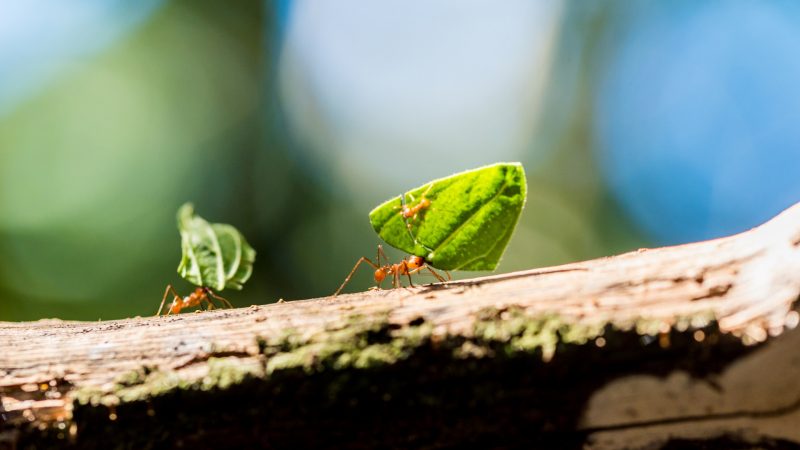
Leafcutter ants are unique species with a very special skill: They are agriculturalists! These unique creatures will cut grass and other plants and then return them to their nest. This will be mixed with ant fecal matter and spores of the fungus.
Eventually, mushrooms will grow inside the nest, providing the leaf-cutter ants with a convenient food source!
What Do Harvester Ants Eat?
Harvester ants’ diets consist mainly of seeds but will also eat dead insects and grass. An interesting fact about harvester ants: they have been known to travel up to 31 miles away from their nests in search of food!
Unlike other ants, this species doesn’t usually pose a nuisance to humans, as they are not commonly known to enter homes in search of food.
What Do Velvet Ants Eat?
Velvet ants, despite the name, are not ants at all. They are a species of wasp! It can be easy to confuse females with “velvety” looking ants due to their fuzzy, wingless appearance. Velvet ants, like bees and wasps, eat nectar from plants.
What Do Green Tree Ants Eat?
Green tree ants, also known as weaver ants, are a unique species of ant found in the northern region of Australia. They are known for building their nest in trees between living leaves. They primarily eat small insects and honeydew secretion.
These ants are known for their unique relationship with blue butterflies. When blue butterflies are ready to lay their eggs, they will search for a green tree ant nest and lay their eggs near the nest. The ants find the larvae when the eggs hatch and carry them back to their ant nest.
This is where something incredible happens: instead of the ants eating the larvae, they take care of them! The ants watch over the larvae, protecting them from predators and helping them find food.
In the meantime, the larvae provide the ants with honeydew secretions to eat. After the larvae have completely developed and are ready to leave the nest, the ants simply let them go.
What Do Queen Ants Eat?
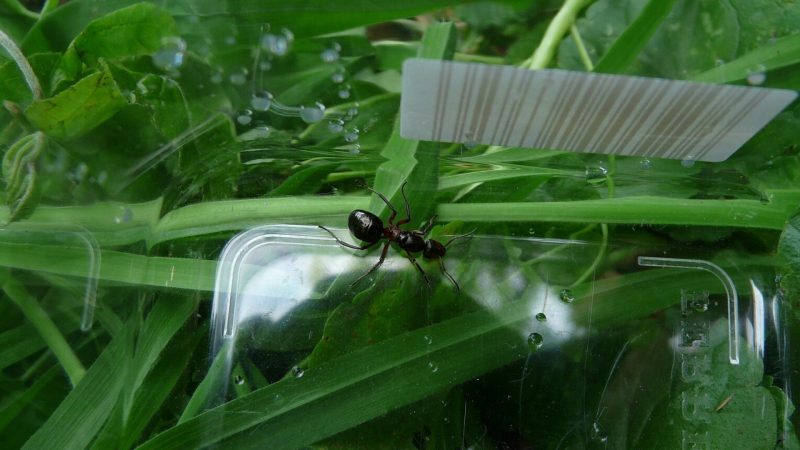
Queen ants eat whatever their colony eats. But because queen ants rarely leave their nests, they will typically get served their food in the nest where they lay their eggs. Most species of ants have workers responsible for feeding the queen and removing her waste while she is busy laying eggs. (She can use all the help she can get, as some species of queen ants can lay millions of eggs in her lifetime!)
Related: How Many Types of Ants Are There: Ant Identification Chart
How to Prevent Ants From Invading the Kitchen?
Store as much food as possible in the refrigerator, especially ripe fruits and vegetables. Be sure to wipe down countertops after each meal, as ants will be attracted to any remaining crumbs, sugar, or juice.
Clean up any spills as quickly as possible. Also, the store opened food packages in sealed containers and takes the garbage out regularly. Ants are also attracted to water sources. So check your plumbing for any leaks that might attract the ants’ attention.
It’s always a good idea to check for any cracks around your windows and doors. If you have any, use a caulking gun (or hire someone). This is to ensure your house is sealed correctly. If you have pets, clear any uneaten food from their bowls once they’ve finished eating. Even a few crumbs of pet food left behind can trigger an ant problem in your home.
What to Do if Ants Are Already in the Kitchen?
If you find ants in your kitchen, don’t panic. There are a number of things you can do. You could call an exterminator, but you can save some money by taking care of the problem yourself.
Try using a 50/50 mix of water and vinegar to wipe up the ants and all kitchen surfaces. The solution will kill them and help erase any pheromone trails they may have left behind. If you are persistent, doing this several times a day will help take care of your ant problem.
If you continue to have issues, consider purchasing an “ant bait” product. Ant bait contains an ingredient that tastes sweet to ants but will be deadly to the colony when brought back to the nest.
- Metal Ant Killer Bait: Attracts and kills many different species...
- Food Lure Ant Bait: The child-resistant metal bait stations use 4...
- How it Works: Worker ants carry and share the bait with the rest...
- Quick Results: Starts killing worker ants within 24 hours; you...
- Usage: Homeplus Ant Killer AB baits are great for getting rid of...
The more ants that come in contact with the ant bait, the more damage will be done to the colony.
You can also try using diatomaceous earth around the points of your house you believe ants may be entering; it is an all-natural powder that can help kill and deter insects.
- 100% Chemical-Free: Made from 5lbs of food-grade freshwater...
- OMRI Listed for Organic Use: Certified by the Organic Materials...
- Powder Duster Included - Powder duster in the bag for easy and...
- Powder Duster Included for Easy Application: Comes with a powder...
- Sourced and Packaged in the USA: Responsibly mined in Nevada and...
Just be sure to keep the powder away from children and pets, as breathing in diatomaceous earth can irritate the lungs.
Can Ants Transmit Diseases to People?
While most people consider ants more of a nuisance than a danger, it’s important not to overlook their potential to spread bacteria and diseases. Ants are capable of transmitting diseases such as E. coli and salmonella.
List of Sources
Lanan M. (2014). Spatiotemporal resource distribution and foraging strategies of ants (Hymenoptera: Formicidae). Myrmecological news, 20, 53–70.
Lenzen C., Radeva T., The Power of Pheromones in Ant Foraging
Red Harvester Ants, Texas A&M AgriLife Extension
Nyamukondiwa, C., & Addison, P. (2014). Food preference and foraging activity of ants: recommendations for field applications of low-toxicity baits. Journal of insect science (Online)
Velvet Ants, Missouri Department of Conservation
- How to Get Rid of Copperheads | Practical Guide - August 27, 2023
- How to Get Rid of Corn Snakes | What Makes Them Aggressive? - August 27, 2023
- How to Get Rid of Alligators | Safety Measures and Removal Methods - July 16, 2023


